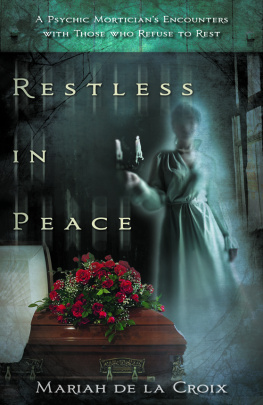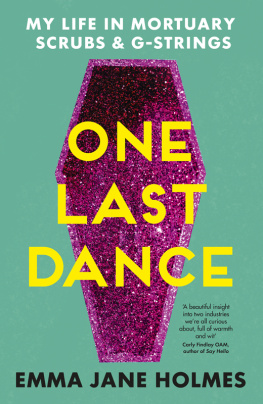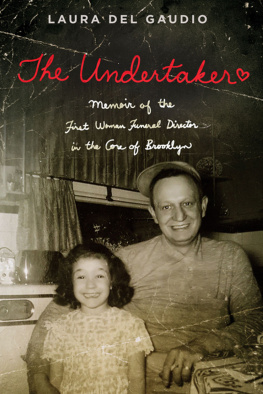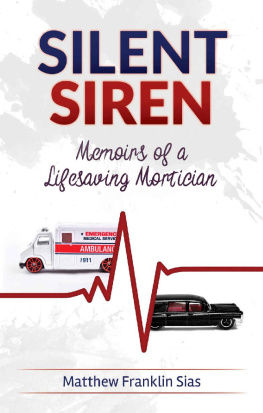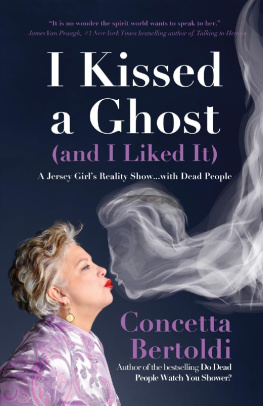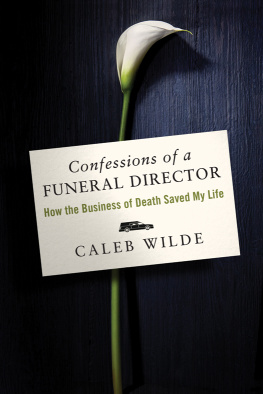J UNE K NIGHTS N ADLE graduated from the Cincinnati College of Mortuary Science in 1945 and began work in the mortuary business just after World War II, in an era when most women had few career options. Her career as a licensed funeral director and embalmer covered fifty years during which she worked in Los Angeles and Salt Lake City. She is now retired and lectures frequently on the topic of creating a dialogue with death to be better prepared for the inevitable. She lives in the beautiful red rock country of St. George, Utah, with her cat, Purrcules.
Acknowledgements
I appreciate the families who gave their permission for me to tell their stories in the hope it might help others who find themselves in similar circumstances.
Many thanks to my agent, Lorin Rees, of the Helen Rees Agency in Boston. Upon receiving my stories he said, I think you have something here. Then thanks to Alma Bune of Inner Ocean Publishing who agreed with Lorin after other editors said, Death wont sell. Alma sent Angela Watrous to me to give tremendous editorial help to this mortician who wanted to tell her stories.
My gratitude to my second husband, Ed, who used reverse psychology by saying to me in 1983, Youll never write that book. But I did. Then in 2001, after serving as my major critic for eight years, he said, I wont live to see your book published. He didnt.
I extend my thanks to those who went the extra mile to assist me: Jean Cruickshank, Cathy Hoyt, Josh Sens, Jacquelyn Hurst, Dawn Sandberg, Douglas and Corine Parker, Ron Broomhead, Nonna Kocharyan, Angela Graham, Rebecca Newman of UCLA, my family of Hamiltons (my maiden name), and Eds grandchildren who cheered me on. I was learning to use a computer when my actor friend, Johnny Mask, read the manuscript and said, Great stories. Now turn on your spell checker, girl.
To the fourteen members of a book club I belong to, who read for me, gave me feedback, and asked questions, I give a great big THANK YOU!

| NEW WORLD LIBRARY is dedicated to publishing books and other media that inspire and challenge us to improve the quality of our lives and the
world. |
We are a socially and environmentally aware company, and we strive to embody the ideals presented in our publications. We recognize that we have an ethical responsibility to our customers, our staff members, and our planet.
We serve our customers by creating the finest publications possible on personal growth, creativity, spirituality, wellness, and other areas of emerging importance. We serve New World Library employees with generous benefits, significant profit sharing, and constant encouragement to pursue their most expansive dreams.
As a member of the Green Press Initiative, we print an increasing number of books with soy-based ink on 100 percent postconsumer-waste recycled paper. Also, we power our offices with solar energy and contribute to nonprofit organizations working to make the world a better place for us all.
Our products are available
in bookstores everywhere.
For our catalog, please contact:
New World Library
14 Pamaron Way
Novato, California 94949
Phone: 415-884-2100 or 800-972-6657
Catalog requests: Ext. 50
Orders: Ext. 52
Fax: 415-884-2199
Email:
To subscribe to our electronic newsletter, visit
www.newworldlibrary.com
I was born and raised in southeastern Idaho on a small farm. We grew potatoes in the valley and Dad raised sheep in the mountains of Wyoming.
I used to hang around the lambing corrals while my father and the other men worked. When a mother ewe is ready to drop, or give birth, she is placed in a small pen so that she and her new offspring can be observed. If the birth goes well and mother and baby have no trouble bonding (every now and then, a free-spirited ewe decides shed rather not be bothered by the trials of motherhood and rejects her lamb), the pair is moved to a pen with ten others, where they spend a few days getting used to being with other sheep. At that point they join a larger group of fifty or so ewes. This happens again and again until a herd of some one thousand ewes has been assembled and is ready to hit the open range.
Rejected or orphaned lambs are known as bum lambs and my younger brother, Rex, and I raised around fifty of them each year. We used large root beer bottles full of milk with oversized nipples we purchased at the drug store for a nickel. The lambs were an ambitious lot. They often knocked us down in a mad dash for their food. We soon learned to put the nipple through the wire fence, but it was difficult to take the bottle from one lamb and give it to another. The chronically famished little creatures climbed over and under each other in their battle to be the first to latch onto the nipple. They never seemed to have enough milk even though their bellies bulged.
I discovered one year that it wasnt wise to make pets of them. Although my name is not Mary, I had a little lamb that followed me everywhere I went. I loved her and she loved ice cream, so every day I shared my ice cream with her. Then came August and it was time for her to be sold off to become someones dinner. As she was loaded on a freight car headed for Chicago, I couldnt help but think about how the ice cream Id fed her had prepared her all-too-well for the market.
Farm life teaches you a lot about the realities of life and death. When I was nine years old, I had a tortoiseshell cat named Tabby who brought many lessons into my life. Tortoiseshells are always female and usually mild mannered. Their fur is patterned with small patches of brown, orange, black, and gray. Every night at bedtime, Tabby would push open the screen of my bedroom window, crawl under the covers, put her head next to mine on the pillow, and purr me to sleep. She exited the same way every morning when she heard my parents stirring downstairs, as if she knew they disapproved of farm animals in the house.
At some point Tabby became pregnant, and near her delivery time she settled into a clean corner of our coal shed. I put pieces of old blankets down for her bed. When she didnt appear for breakfast one day, I went to her bed and found her in the throes of labor. Her whole body seemed to spasm with each labor pain, and she reached for my hand with her paw. I sat by Tabby until the afternoon, but still she had not produced a kitten. She would grasp my hand with her bare claws as the pains came. I summoned Mother and she applied gentle pressure in two or three places before announcing that a kitten was coming breech. She told me I could very gently and slowly pull on the end of the kitten to help Tabby. Then Mom returned to the house.
I eased the birth by pulling gently on the kittens tail, and when it finally came out it was obviously stillborn. In a few minutes a live kitten came and I helped to clean it up with a piece of toweling. Then a deformed kitten presented itself and breathed only a minute or so before dying. All of this birth and death happened in a few minutes. There was little need for the birds-and-bees lecture for those of us raised around animals.
After that Tabby and I had two wonderful years together, during which she was playful and cuddly. Then she started to lose her appetite and sleep a lot. Her loss of weight was noticeable, but on the farm no one ever thought of a veterinarian for any animal except horses and cows. Small animals that became ill or maimed were usually shot. It was neither cruel nor kind. It just was. Still, I asked Dad not to shoot Tabby when she became obviously too ill to recover. He agreed and I held her while she died. Yes, my heart was broken, but Dad helped me bury her.
While I was sad at losing my pet, I was grateful I could care for her and hold her to the end. That way, I didnt have to wonder about how she died. I didnt need to worry that another animal had disturbed her. I knew she had comfort from being in my arms. I felt a peace in my own mind by staying. Years later when I was with my husband in his passing, that same peace came to me.
Next page

